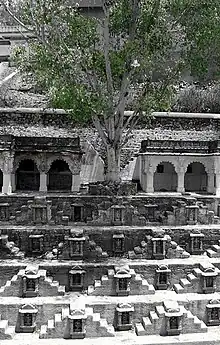

Brahma Kund[upper-alpha 1] is a stepped temple tank in Sihor town of Bhavnagar district, Gujarat, India. It is located near the southern wall of the old town. It believed that it was constructed by Jayasimha Siddharaja.[1]
History
The exact dates of Brahma Kund is unknown. It mentioned in Skanda Purana.[1]
According to legend, Chaulukya king Jayasimha Siddharaja was suffering from skin disease following the curse from Ranakadevi, the queen whom he captured from Junagadh. He was cured after bathing in this tank so he refurbished the tank. The water of the tank is still considered miraculous.[1] It is mentioned in Prabandha-Chintamani written by Merutunga. The tank kept finding its reference and mentions citing Siddharaja since 12th century.
It is also mentioned in Ain-e-Akbari. Poet Nanalal Dalpatram Kavi expresses and explains in his Hari Samhita that Krishna had visited the place.
Architecture
Brahma Kund, built in the style of medieval architecture, has a design of steps, small temples, metaphors, motifs and beliefs, idols of Hindu deities, stone work, some scientific entities, everything carved within and across the complex.[2]
There is Neelkanth Mahadev temple near the tank. There is a lake known as Gautam Lake and Gautameshwar temple is located nearby.[1]
The tank is the State Protected Monument (S-GJ-35). It is now poorly maintained.[3]
Culture
On the last day of Shraavana month, called as Bhadarvi Amas or Bhadrapad Amavasya, the fair is organised at the place which is attended by tens of thousands people.[4]
See also
Notes and references
Notes
References
- 1 2 3 4 Gazetteer of the Bombay Presidency. Printed at the Government Central Press. 1884. pp. 541, 655.
- ↑ Shukla, Rakesh (9 March 2014). "ક્યારેક ચાંદીના આભૂષણોના વેપાર માટે જાણીતું હતું ગુજરાતનું આ શહેર-વિસ્તૃત કોતરણી". gujarati.oneindia.com (in Gujarati). Retrieved 3 October 2016.
- ↑ "બેદરકારીને લીધે પુરાતન સ્થાપત્યોનું સૌંદર્ય નષ્ટ". Divyabhaskar (in Gujarati). 21 October 2011. Archived from the original on 30 December 2016. Retrieved 30 December 2016.
- ↑ India. Office of the Registrar General (1969). Census of India, 1961: Gujarat. Manager of Publications. pp. 31–32.
As of this edit, this article uses content from "Brahma Kund, Sihor and Siddharaj Jaisinh", which is licensed in a way that permits reuse under the Creative Commons Attribution-ShareAlike 3.0 Unported License, but not under the GFDL. All relevant terms must be followed.